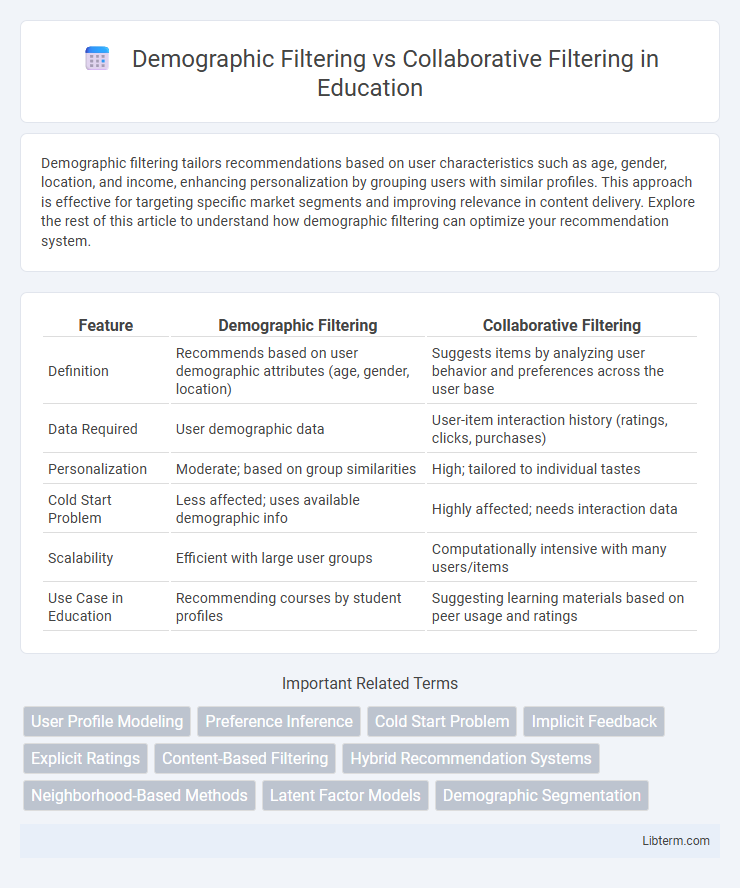Demographic filtering tailors recommendations based on user characteristics such as age, gender, location, and income, enhancing personalization by grouping users with similar profiles. This approach is effective for targeting specific market segments and improving relevance in content delivery. Explore the rest of this article to understand how demographic filtering can optimize your recommendation system.
Table of Comparison
| Feature | Demographic Filtering | Collaborative Filtering |
|---|---|---|
| Definition | Recommends based on user demographic attributes (age, gender, location) | Suggests items by analyzing user behavior and preferences across the user base |
| Data Required | User demographic data | User-item interaction history (ratings, clicks, purchases) |
| Personalization | Moderate; based on group similarities | High; tailored to individual tastes |
| Cold Start Problem | Less affected; uses available demographic info | Highly affected; needs interaction data |
| Scalability | Efficient with large user groups | Computationally intensive with many users/items |
| Use Case in Education | Recommending courses by student profiles | Suggesting learning materials based on peer usage and ratings |
Introduction to Filtering Techniques in Recommendation Systems
Demographic Filtering in recommendation systems leverages user attributes such as age, gender, and location to suggest items that align with similar demographic profiles, enhancing personalization accuracy. Collaborative Filtering relies on user interaction data, using patterns of item preferences and behaviors across users to generate recommendations without requiring explicit user attributes. Both techniques serve critical roles in recommendation engines by addressing personalization from distinct data-driven perspectives, optimizing user experience through targeted content delivery.
Understanding Demographic Filtering
Demographic filtering personalizes recommendations based on user attributes such as age, gender, location, and occupation, leveraging static demographic data to segment users into groups with shared characteristics. This method is effective in new-user scenarios where behavioral data is limited, providing relevant suggestions by assuming similar preferences among users with similar demographics. Unlike collaborative filtering, which relies on user-item interaction history, demographic filtering does not require extensive behavioral data, making it useful for cold-start problems but potentially less precise in capturing individual tastes.
The Mechanics of Collaborative Filtering
Collaborative filtering operates by analyzing user behavior patterns and preferences to generate personalized recommendations based on similarities between user profiles or item attributes. Unlike demographic filtering which segments users by predefined characteristics like age or location, collaborative filtering uses matrix factorization or nearest neighbor algorithms to predict user interests from historical interaction data. This method adapts dynamically to evolving user tastes and scales effectively with large datasets due to its reliance on collective user data rather than static demographic categories.
Key Differences Between Demographic and Collaborative Filtering
Demographic filtering recommends items based on users' attributes such as age, gender, location, or occupation, relying on demographic data to predict user preferences. Collaborative filtering, on the other hand, analyzes user behavior and interactions, like ratings or purchase history, to find patterns and suggest items preferred by similar users. The key difference lies in demographic filtering's use of explicit user characteristics versus collaborative filtering's reliance on implicit user behavior data for recommendation accuracy.
Advantages of Demographic Filtering
Demographic filtering offers precise targeting by leveraging user-specific attributes such as age, gender, location, and occupation, enhancing recommendation relevance. This method excels in cold-start scenarios where user interaction data is sparse, providing a reliable basis for initial recommendations. By using easily accessible demographic data, it ensures quicker and more interpretable recommendations compared to complex collaborative filtering techniques.
Benefits of Collaborative Filtering
Collaborative filtering excels in providing personalized recommendations by analyzing user behavior and preferences rather than relying solely on demographic data, which enhances accuracy and relevance. It adapts dynamically to individual tastes, offering diverse suggestions even for users with unique or evolving interests. This method also effectively uncovers hidden patterns and correlations in large datasets, improving recommendation quality across varied user profiles.
Limitations and Challenges of Each Filtering Method
Demographic filtering struggles with accurately capturing diverse user preferences due to its reliance on static user attributes, leading to limited personalization and cold-start problems for new users. Collaborative filtering faces challenges with data sparsity and scalability, often resulting in decreased recommendation quality when user-item interactions are insufficient. Both methods require extensive user data, raising privacy concerns and potential biases in recommendation outcomes.
Use Cases: When to Use Demographic vs Collaborative Filtering
Demographic filtering excels in scenarios with limited user interaction data by leveraging user attributes such as age, gender, or location to deliver personalized recommendations, making it ideal for new users or cold start problems. Collaborative filtering outperforms when extensive user-item interaction data is available, enabling it to identify complex patterns and preferences through user behavior similarity, which suits mature platforms with active user engagement. Combining both approaches enhances recommendation accuracy by addressing cold start issues and capturing nuanced user preferences across diverse contexts.
Hybrid Approaches: Combining Demographic and Collaborative Filtering
Hybrid approaches that combine demographic filtering and collaborative filtering leverage the strengths of both methods to enhance recommendation accuracy. By integrating user demographic data such as age, gender, and location with collaborative insights derived from user-item interaction patterns, these systems address limitations like cold-start problems and sparse data. This fusion enables personalized recommendations that reflect both user preferences and behavioral similarities, resulting in improved user satisfaction and engagement.
Future Trends in Recommendation System Filtering Techniques
Demographic filtering leverages user attributes such as age, gender, and location to customize recommendations, whereas collaborative filtering analyzes user behavior and interactions to identify patterns and preferences. Future trends in recommendation systems emphasize hybrid models that integrate demographic, collaborative, and content-based filtering with advanced deep learning techniques and contextual data to enhance accuracy and personalization. Emerging approaches also focus on leveraging real-time user context, multi-modal data, and privacy-preserving algorithms to address scalability and ethical concerns in recommendation filtering.
Demographic Filtering Infographic

 libterm.com
libterm.com